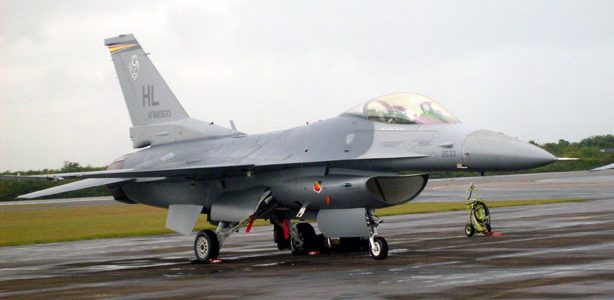by Budd Davisson
The F-16 Falcon, AKA Viper, is a maverick, borne of mavericks and for years was at odds with much of the Air Force establishment. They resented the fact that the airplane had been literally rammed down their throats by congress as the result of the persuasive lobbying efforts of what has become known as the Fighter Mafia, which included, among others, legendary fighter pilot/tactician John Boyd and test pilot Chuck Meyers.
Right after Vietnam a lot of coffee was consumed in a lot of smoke-filled rooms while the fighter community de-briefed what had been a nearly embarrassing lack of dominance in their chosen profession. Both services had been ripping around in the terrifically expensive, unbelievably fast, super sophisticated and pretty darned big Phantoms yet it was sometimes all they could do to maintain a 2:1 kill ratio against the motley collection of MiGís North Vietnam threw against them.
The Navy started work in a new direction that eventually produced the F-14, while the Air Force developed the F-15, which the Fighter Mafia felt confirm that The Establishment hadn’t been listening to the lessons learned in ‘Nam. The Phantom had proved that killing a target beyond visual range (BVR) with missiles wasnít practical because radar couldnít tell whether the target was ours or theirs. It also proved speed was highly over rated because, after one turn, all fights burn down to sub-sonic levels where the super light, highly powered MiGs could turn inside a Phantom and eat him for lunch. Plus the tiny MiGs were practically invisible while the hulking Phantoms were hard to miss.
The F-15 was bigger than the Phantom and cost even more so fewer could be built. The Fighter Mafia argued for a much lighter, higher powered airplane that could be built for nickels and dimes (government nickels and dimes are bigger than yours and mine) and could pull a solid 9 Gís at the speeds at which it would be fighting . Prior to that, 7 Gís was about the limit and the Phantom burned so much speed in a high G turn that it practically came to a halt.
The Mafia won and a contest was held with the finalists being Northropís XF-17, that eventually became the Navyís F/A-18 and General Dynamicís F-16.
At little over half the weight of an F-15 with similarly reduced costs, the F-16, despite its rocky acceptance has proven to be an unqualified success. A relatively small airplane, its blended wing configuration gives it much more internal fuel storage than would be expected, and its 30 degree reclined seating lets the pilot pull heavy Gís without blacking out. Its one-piece canopy, a fighter first, gives better visibility, but because it is thicker precludes ejecting through it. The side stick controls of the Viper/Falcon take some getting used too, as they are really not meant to move: they sense pressures that are then transmitted to the computers that are actually flying the airplane.
For maximum maneuverability, the airplane is designed to be so unstable that, should all four of its computers fail, it would almost instantly tumble from controlled flight and be torn to shreds. That hasnít happened.
What has happened is that the airplane has become one of the most universally accepted (itís operated by over 24 countries), most cost effective fighters of this generation. It will be many decades before the F-16ís are forced out by a more able successor. Itís going to be a hard act to follow, as itís still the biggest bang for the fighter buck.

















I heard from someone a long time ago that the Israeli Air Force trained its pilots to be able to withstand greater “g” forces than the max of 9 g’s specified in the operations manual. Allegedly, the limiter/software could be tweaked to allow greater (I heard 11 g’s) forces to be permitted and not only would their pilots not black out, but the airframe held together just fine.
Any truth to this, or is it one of those apocryphal tales that gets told so often, it takes on a ring of truth?!
Yes indeed. Not only were the planes tough to beat, the pilots who flew them were as well. I knew some F16 pilots and they were a wild bunch that could take a beating and like it.